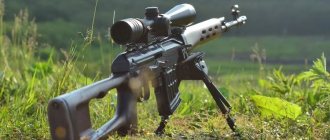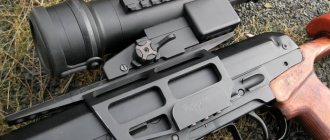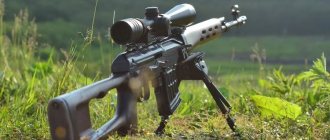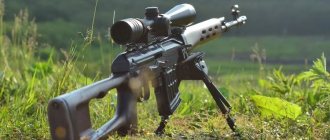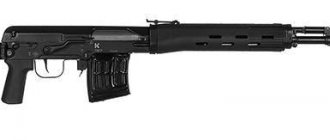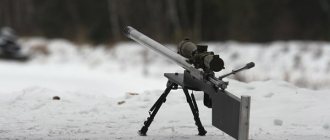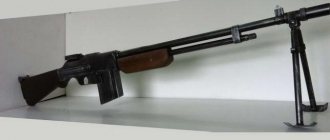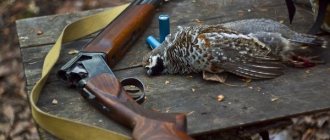Description Tiger 9
The barrel of this carbine is chrome plated and 565 mm long. In general, the length of the carbine varies from 1130 to 1180 mm, depending on the type of stock, which can be either hunting or orthopedic, equipped with a rubber butt pad. The carbine is powered by 9.3x64 mm 9-caliber ammunition. Automatic reloading of the Tiger 9 hunting carbine is produced as a result of the combustion energy of gunpowder gases, which evaporate from the barrel channels into the gas chamber through the gas outlet.
The bolt is locked onto three lugs with a rotating movement around its axis as the frame slides along. The trigger mechanism operates from the trigger and provides single firing, as well as installation on the safety. The trigger system mechanism is detachable, and the firing pin is spring-loaded. The safety catch of the Tiger 9 hunting carbine is located on the receiver on the right side. The mount for optical sights and other devices is located on the left so that it does not interfere with the use of an open type sight, which consists of an aiming bar and a bear, adjustable in two planes. The optimal range for using an open sight does not exceed 300 meters.
Technical characteristics of Tiger carbines
Tiger in Spanish 01
- Caliber: 7.62×54R
- Weapon length: 1100 mm
- Barrel length: 620 mm
- Weight without cartridges: 3.8 kg.
- Magazine capacity: 5 or 10 rounds
Tiger in Spanish 02
- Caliber: 7.62×54R
- Weapon length: 1100/840 or 1200/940 mm
- Barrel length: 530 or 620 mm
- Weight without cartridges: 3.9 kg.
- Magazine capacity: 5 or 10 rounds
Tiger in Spanish 05
- Caliber: 7.62×54R
- Weapon length: 1225 mm
- Barrel length: 620 mm
- Weight without cartridges: 3.85 kg.
- Magazine capacity: 5 or 10 rounds
Tiger-308
- Caliber: 7.62×51 (.308 Winchester)
- Weapon length: 1100 or 1200 mm
- Barrel length: 565 or 655 mm
- Weight without cartridges: 3.95 kg.
- Magazine capacity: 10 rounds
General characteristics
Although it should be noted that all modifications of carbines have different design options, here are some points that differ from the original version of the Tiger 9 hunting carbine. All models are made with either an orthopedic butt, which has a cutout for the thumb, a hunting and metal one, which easily folds into right side and has a pistol grip. The handguard is made of both wood and high-quality plastic that is resistant to damage. The barrels are equipped with long and short flash suppressors, as well as without flash suppressors. The weight of the weapon does not exceed 4 kilograms. Another interesting detail in the operation of this carbine is the cartridge used. Unlike the 9 mm cartridge, which rapidly loses its energy when fired, the 7.62 mm cartridge, due to its ballistics, shows significantly better results.
New in blogs
Self-loading hunting carbine "Tiger-9"
To understand the absurdity of discussions about the excessive power of the 9.3x64 caliber for Russian hunting, just look at the streets of our cities - aren’t the capabilities of LandCruiser, Patrol, Pajero and other off-road fighters excessive for overcoming asphalt potholes, broken rails and sidewalk curbs? After all, most of the owners of these beauties never test their strength in the real world, and not because of thrift, but because there is no need. Many of them even vaguely understand the purpose of all sorts of multipliers and differential locks, but the presence of an inclinometer and a compass on the dashboard warms the soul! It’s the same story with Tiger-Nine...
Experience shows that the 9×53 and 7.62×54 cartridges available among traditional Russian calibers cope quite well with moose and bears, and self-loading weapons are not accepted for exotic hunts - loyalty to tradition and reinsurance in terms of safety. Moreover, the very appearance of the large-caliber “Tiger” is, in a sense, artificial, since it appeared solely as a consequence of the adoption of the 9-mm SVDK sniper rifle by the Russian army. The ammunition for the new rifle is based on the 9.3×64 Brenneke hunting cartridge, which appeared in the 30s of the 20th century and was intended specifically for those very exotic (African) hunts. Therefore, we can say that the Tiger-9 cartridge is no less a “purebred” hunting weapon than the SVDK is a combat weapon, and there will certainly be a buyer for such a concept. He is unlikely to go to Africa with his “nine”, but there is no doubt about the health of our animal, thanks to the powerful cartridge...
The only thing that the Tiger-9 lacks, as a rather expensive weapon, is real hunting polish. And here the Izhevsk “Legion” comes to the rescue.
The refining recipe is quite simple: 9-mm barrels with the best accuracy are selected (and this is perhaps the most important), and all the “hardware” is placed in a wooden stock made of beautiful walnut. Moreover, the basis for the visual perception of the weapon as a whole is, first of all, formed by the elegant shape of the new forend, extremely well chosen by Izhevsk craftsmen.
The halves of the forend fit well together and do not change their relative positions during repeated disassembly and reassembly necessary for cleaning the gas engine.
The price of the carbine is more than 70,000 rubles, but the power of the basic model, multiplied by the beauty of the individual appearance, is worth it. Moreover, the standard “Tiger-9” cannot be called particularly cheap (up to 40,000 rubles). However, in the St. Petersburg weapons store “Russian Weapons” where we found these samples, there are enough other weapons - smaller in caliber and price.
By the way, this “Tiger” retains the adjustment of the gas engine and installs a recognizable long flame arrester of the “old” model.
Unlike a combat rifle, the Tiger-9's firing pin is spring-loaded. Since hunting cartridges often use much more sensitive (“soft”) primers compared to combat cartridges, such an additional safety measure does not seem superfluous. However, it would not hurt to keep the self-timer, but this is apparently prevented by the licensing authorities. And in vain, because the self-timer in self-loading (not automatic) weapons is intended only to exclude the possibility of firing when the bolt is not closed, and not to ensure firing in bursts.
Probably, the supposedly unbearable recoil of a relatively light (4 kg with an empty magazine without optics with a 565 mm barrel) weapon for such a powerful cartridge deserves a few words.
Real shooting shows that one, two or three shots, necessary for hunting, from any position, if properly prepared, will not tire the shooter at all. My personal experience suggests that if you decide to “abuse” it, then probably after the tenth or twentieth shot you will want to switch to a “lighter” cartridge - more suitable for recreational shooting. For example, 223rd (5.6×45). In particular, five or six years ago in Izhevsk, one ten-round magazine was enough for me to complete my impressions of the SVDK. Or maybe I didn’t finish shooting him...
In general, the recoil of the “nine” is more sensitive than that of the “Tiger” chambered for 7.62×54, but it, in turn, remains within the general concept of a comfortable shot and does not threaten the hunter with loss of health. However, remember that if you bring yourself to an indecently low body weight with a plant-based diet and breathing exercises, then it is better to postpone hunting for large animals altogether until you gain better physical shape.
And if you are mentally and physically ready to take a large-caliber Tiger as your hunting partner, then don’t even doubt its fighting qualities. For example, factory test shooting for a carbine showed a dispersion diameter of 49 mm at 100 m - an excellent result for a self-loading large-caliber weapon. Moreover, this is data with a Russian cartridge (Novosibirsk Cartridge Plant) and a mechanical sight. It is quite possible that with a more expensive imported cartridge (ours costs 70-80 rubles) and optics, the “nine” in good hands is capable of more. Go for it!
Author: Mikhail Degtyarev
Where to use the Tiger 9 hunting rifle
The Tiger 9 hunting carbine is not a universal weapon. Its relatively heavy weight is not convenient for cross-shooting, as well as for classical hunting. Nevertheless, it has proven itself well when hunting medium and large animals in various conditions. The ability to choose a carbine “for yourself”, thanks to a wide range of designs, it will be convenient for any hunter.
In general, Tiger series carbines are high-quality, convenient civilian weapons. Despite the relatively high price, which in most stores ranges around 40,000 Russian rubles, it is very popular. Considering other Tiger models, one should note the same qualities as the ninth, only with individual conditions of use and performance differences. You can order an individual carbine kit using the one provided directly by the manufacturer. And in conclusion, I would like to remind you that the Izhevsk Machine-Building Plant, as well as the mechanical plant, produces high-quality weapons, many of which are unique and collectible, and are also exported to many countries around the world.
About the hunting carbine "Tiger-9"
At the turn of 1940-50, the Izhevsk Machine-Building Plant began production of a new weapon - the M.T. Kalashnikov, and transferred the production of “smooth-bore” guns to the Izhevsk Mechanical Plant. However, rifled hunting weapons are still the calling card of Izhmash, along with the AK.
9 mm hunting cartridges.
1 - 9x53 cartridge with a brass sleeve, 2 - 9x53 cartridge with a bimetallic sleeve, 3 - domestic 9.3x64 cartridge, developed at TsNIITOCHMASH, 4 - 9.3x64 cartridge from the German company Dynamit Nobel In the early 50s, only one carbine was manufactured at the plant - KO-8.2, which was a conversion of an army carbine and previously released Mosin rifles of the 1891/30 model. By the end of the 50s, new hunting cartridges appeared, the development of which was carried out by TsNIITOCHMASH (Klimovsk). Of the powerful cartridges, the most interesting were the 9-mm cartridges, one of which was based on a 7.62x53 cartridge case, and the other on an 8.2 mm cartridge case.
The cartridge, which used cartridges from an 8.2 mm cartridge, somehow did not catch on; the very powerful recoil when fired and the inconvenient flange of the cartridge case made its use in weapons difficult, but the 9x53 cartridge fit well into the automatics of the Dragunov sniper rifle. The result was the Bear carbine. Later, the “Los” carbine was developed for the 9x53 cartridge.
As it turned out later, the 9x53 cartridge was unique in its own way. Similar ammunition was not produced anywhere in the world. Under this cartridge, the TsKIB SOO launched the production of elite weapons in Tula, which were sold in the circles of those in power and sent abroad through diplomatic channels.
The unique shape of the 9x53 cartridge guaranteed the safety of the weapon; it was impossible to shoot with other cartridges. When, on our initiative, the 7.62x51 cartridge (the domestic analogue of the .308Win cartridge) was developed, the head of TsKIB SOO, Ivan Mikhailovich Mikhalev, warned about the difficulties of producing self-loading weapons chambered for a cartridge that was manufactured by dozens of companies. This is what happened at first: different sensitivity of the primers, different values of the momentum of the powder gases, especially at the moment the bullet passed the gas outlet hole, required special measures when testing the weapon mechanisms.
| Characteristics of 9 mm hunting cartridges | |||
| Characteristics | 9x53 | 9.3 x 64 TsNIITOCHMASH, Russia | 9.3 x 64 Dynamite Nobel, Germany |
| Bullet weight, g | 15 | 17,5 | 19 |
| Initial bullet speed, m/s | 640 | 740 | 750 |
However, in the mid-70s, based on existing samples, a weapon was created chambered for the 7.62x51 (.308Win) cartridge, which provided a flatter bullet trajectory compared to the 9x53 cartridge.
With almost the same muzzle energy (about 3,000 J) at distances up to 300 meters, the 7.62 mm bullet, thanks to more advanced ballistics, retains energy of approximately 1555 J, which is significantly higher than for a bullet from the 9x53 cartridge.
As a result, for a number of reasons, the 9x53 cartridge faded into the shadows, but the production of this ammunition did not stop and this has justified itself in our days, when new types of weapons for this cartridge have appeared.
In the 1990s, TsNIITOCHMASH again returned to the idea of developing a powerful 9-mm hunting cartridge (the 9.3x64 Brenneke cartridge was taken as the prototype). In this cartridge, a bullet weighing from 17.5 g to 19 g at distances up to 300 meters retains energy at the level of 3,000 J and, in terms of flatness of trajectory, is slightly inferior to the 7.62x51 cartridge.
It should be noted that the difference in the designation of 9x53 and 9.3x64 cartridges has developed historically.
The caliber of the weapon for both cartridges is the same - 9 mm. A variant of the Tiger-9 hunting carbine with a butt and fore-end made of glass-filled polyamide.
At first glance, this is a Dragunov sniper rifle, but the shape of the magazine and the markings on the receiver convince us that this is a “Tiger-9.” And again, the weapon chambered for the new 9.3x64 cartridge was designed on the basis of the Dragunov sniper rifle. A significant increase in the length of the cartridge compared to a standard rifle cartridge (by approximately 10 mm) led to the fact that the bolt stop mechanism had to be removed to accommodate the magazine.
The Tiger-9 carbine, chambered for 9.3x64, has a longer barrel and a short conical flash suppressor, similar to the flash suppressor of the Dragunov sniper rifle with a folding SVDS stock.
Significant changes have been made to the design of the locking unit.
Due to the increased power of the cartridge, the areas of overlap between the bolt lugs and the receiver have been increased. The bolt has a so-called “closed cup” for the flange of the cartridge case, that is, the cartridge case in the ejector area is completely covered by the bolt. Hunting carbine "Tiger-9".
Having inherited from the Dragunov sniper rifle a number of exceptional qualities inherent in it, the Tiger-9 has every chance of becoming the favorite weapon of large game hunters. The Tiger carbine is structurally similar to the Dragunov sniper rifle. When put into service, the rifle passed the entire test cycle, including testing for safety in handling. Many years of operating experience in parts have proven the high reliability, mechanical strength and safety of the rifle. However, in hunting practice there are experiments by “craftsmen” to “strengthen” cartridges, leading to the rupture of the carbine. When analyzing the destruction of carbines, it was noted that they are similar to the destruction of a sniper rifle, which occurs, for example, when fired with a bullet stuck in the barrel or with the barrel bore completely filled with water. In such cases, powder gases break out of the cartridge case in the ejector area, bend or break off the front part of the frame, and sometimes the receiver cover breaks off the guides.
Similar destruction of the carbine was obtained when firing cartridges reloaded with Sunar gunpowder or loaded with a mixture of VT and Sunar gunpowder in a 1:1 ratio. The pressure in the barrel bore when firing such cartridges exceeds 7000 kgf/cm2.
| Technical characteristics of the Tiger-9 carbine | |
| Caliber, mm | 9 |
| Cartridge used | 9.3x64 |
| Carbine weight, kg | 4,0 |
| Length of carbine with orthopedic butt, mm | 1130 |
| Length of carbine with hunting stock, mm | 1180 |
| Barrel length, mm | 565 |
| Magazine capacity, cartridges | 5 |
| Dispersion diameter of 4 bullets at a distance of 100 m: - when using a domestic cartridge, mm - when using a foreign-made cartridge, mm | 60 30-40 |
Similar tests were carried out on the Tiger-9 carbine with a closed bolt cup. Tests have shown that the strength of the locking mechanism has increased significantly. The carbine can withstand both a shot with the barrel completely filled with water, and a shot in which the bullet of the next cartridge rests on a second bullet hammered into the bullet entrance. But, nevertheless, when firing a 9.3x64 cartridge fully loaded with Sunar gunpowder, the carbine is destroyed, and the bullet stops near the gas chamber. Powder gases break through the cartridge case in the extractor recess area. There is a separation of the front part of the bolt frame. The bolt and receiver lugs are not destroyed.
Therefore, fellow hunters, do not try to improve the cartridge or improve the flatness of the bullet trajectory by adding fast-burning powders intended for shotguns. In rifled weapons, this leads to abnormally high pressures in the bore of the weapon and ultimately to injury or disfigurement to the shooter.
Compared to previously produced hunting cartridges with a muzzle energy of about 3,000 J, the 9.3x64 cartridge has a muzzle energy of 5,300 J and, accordingly, a powerful recoil impulse. Nevertheless, when firing from a Tiger-9 carbine, its magnitude does not exceed the recoil impulse when firing from a 12-gauge weapon. This is facilitated by the correctly selected mass of the recoil parts of the carbine; a conical flash suppressor that simultaneously acts as a muzzle brake and a rubber butt plate that makes shooting more comfortable.
The team of the advanced development design bureau, where the Tiger-9 carbine was created.
To reduce the deviation of the carbine from the aiming point during a shot, the flame arrester is equipped with a wide compensator jumper, acting on which the powder gases prevent the weapon from moving away from the aiming line.
The powerful ballistics of the Tiger-9 carbine places increased demands on optical sights. Of the sights produced by our industry, the most suitable for the Tiger-9 carbine are optical sights of the PSO-1 type. Such sights are designed to withstand very high loads when shooting.
The "Tiger" and "Tiger-9" carbines, which have adopted all the best from the Dragunov sniper rifle (stable automatic system, reliable locking unit, good accuracy of fire), can show exceptional results when shooting with a high-quality cartridge. This was proven by accuracy shooting of the Tiger-9 carbine with 9.3x64 Dynamite Nobel cartridges. Therefore, today our cartridge makers are faced with the most difficult task - when mastering the domestic version of the cartridge, not to lose the qualities that foreign analogues have.
Izhmash OJSC plans to begin production of a small series of Tiger-9 carbines in 1999.
Azariy Nesterov
